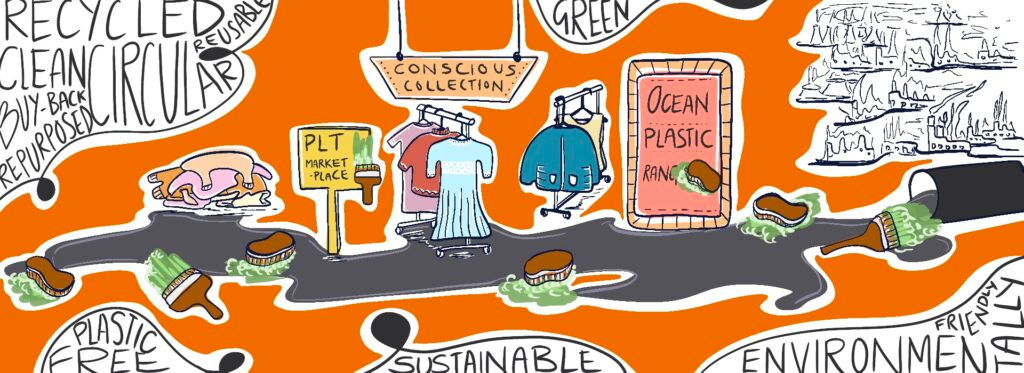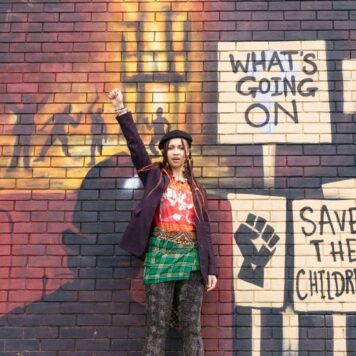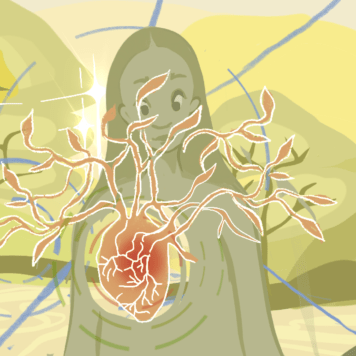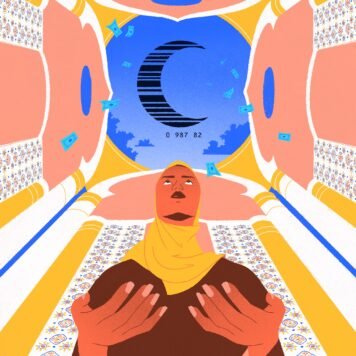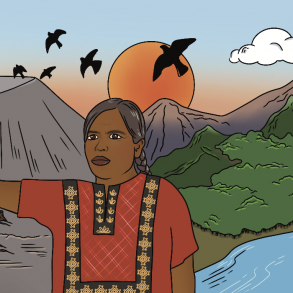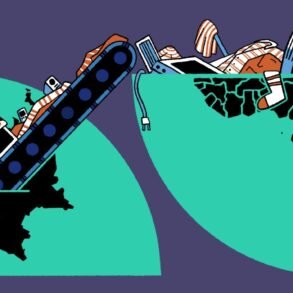What is Greenwashing?
Greenwashing is when an organisation or business is misleading about its environmental credentials. They engage in behaviour, activities or marketing to make us believe that they are doing something for the benefit of the environment, usually in a bid to make us buy more. Corporations are hijacking terms such as “sustainable”, “environmentally friendly” and “circular” with no evidence to support their claims.
How do brands benefit from greenwashing?
Greenwashing’s origins are in oil – what else?! In the mid 1980s, oil company Chevron created a marketing campaign titled People Do. They ran television and print advertisements to express their support for nature. During this time, Chevron was actively violating the Clean Air and Clean Water acts, as well as spilling oil into wildlife areas.
Present day examples of greenwashing in fashion include H&M’s ‘Conscious Collection’, Pretty Little Thing’s resale app ‘PLT Marketplace’ and Adidas’ Ocean Plastic range. Not only do these fast fashion brands overproduce products at a rate that our planet simply cannot sustain, they have faced multiple allegations of garment maker exploitation, such as chronically low wages, unsafe working conditions, wage theft and gender-based violence.
How is capitalism and the exploitation of resources and people linked to greenwashing?
The capitalist system means that the majority of power, profits and decision making lies with the top executives of a corporation – usually white men based in the Global North. They also own the ‘means of production’ (how goods and services are created) and operate for profit.
The Global apparel market is valued at $3 trillion, with one in six people working in the fashion supply chain; however, the vast majority of garment makers – most of whom are women – are not earning a fair living wage. The fifteen richest people in the industry are worth a combined $410.8 billion.
This industry is built on colonial infrastructures: it was built to benefit a select few, at the cost of the majority of people in the supply chain. The system wasn’t built to be in reciprocal benefit to people and planet, so we end up with a never ending stream of greenwashing campaigns because the system is rigged.
Big Fashion brands cannot claim to be ‘good’, until they restructure their business model to produce fewer clothes and redistribute their wealth and power for the betterment of the people creating their products.
Why is greenwashing a global issue?
This is a global issue because brands participate in a concept referred to as ‘The Race to the Bottom’. This is when corporations push garment factories and entire countries to the lowest prices for producing goods for as little as possible. This means that if labour or environmental laws increase in a country like Bangladesh, companies notice their profit margins will shrink and move all their business to another country with fewer laws protecting people or planet.
This is a tool of global capitalism: profits at the cost of workers rights, safety and respect for the planet. We are all interconnected. If something is harming one of us, ultimately it is harming all of us.
What groups are left out of conversations or disproportionately impacted by greenwashing?
It’s always garment makers, the people without whom, the fashion industry simply would not exist. In 2020, I co-founded a campaign called Remember Who Made Them. As billions of dollars of orders were cancelled by retail giants, many workers were still forced to work in unsafe conditions, all to help the top executives make a profit from “Clap For our NHS” t-shirts. As a group of concerned feminists, allies and artists we came together, catalysed by the plight of fashion garment workers who’ve globally been impacted by the crisis and been exploited for long before then, to help inspire a new solidarity economy.
In our podcast series, we had conversations with garment makers, organisers and union leaders from places including Sri Lanka, Pakistan, Mexico and Bangladesh to learn about their demands, celebrate their craft and demand that Big Fashion starts putting people over profit.
Myth busting: what are the biggest misconceptions and can you eradicate these?
The main message I want to communicate is that we cannot have sustainability unless every single person in the supply chain is paid a fair living wage. We also need brands to commit to a drastic decrease in over-production, because our planet can’t cope!
Who cares if Nike aim to “Move to Zero” when the person who made their items wasn’t paid a fair living wage?
Who cares if H&M have a take back programme when the incentive is for us to buy more clothes we don’t need?
What’s the use in PLT’s resale app when their aim is to produce more brand new clothing year-on-year?
Who are some of the key organisations in the movement?
I organise with Labour Behind The Label and Clean Clothes Campaign who work to improve the garment industry and protect garment makers. Close allies include War On Want who fight poverty and defend human rights, grassroots solidarity campaign No Sweat who fight against sweatshops, and Oh So Ethical, a garment maker rights blog with whom I co-organised a protest to take a stand against boohoo for their illegal garment maker wages in Leicester of £3.50 an hour (and endless greenwashing).
My friends at The Or Foundation are based in Accra, Ghana. They work at the intersection of environmental justice, education and fashion development, with a mission to create alternatives to the dominant model of fashion that take care of every person in the value chain, protect the planet and inspire us to see ourselves as citizens, not consumers.
Someone I look up to a lot is Anannya Bhattacharjee, who is the International Coordinator for Asia Floor Wage Alliance and President of Garment and Allied Workers Union in North India. Asia Floor Wage Alliance is an Asian-led global alliance of trade unions and labour organisations fighting for living wages, freedom of association, and a violence free workplace for women workers in garment global supply chains.
Campaigns like Good Clothes Fair Pay and Remake are doing awesome work to be in solidarity with garment makers and push for policy.
Wins
Thanks to citizens applying pressure to brands and greenwashing watchdogs, we’re beginning to see more brands being outed for greenwashing and there are folks working on legislation to prevent this from happening in the first place.
The Competition and Markets Authority CMA published its Green Claims Code in September 2021, which aims to help businesses understand how to communicate their green credentials, while avoiding the risk of misleading shoppers.
H&M and Decathlon have both made commitments to the Netherlands Authority for Consumers and Markets (ACM) to remove sustainability-related labels from their products and websites, and to improve the use of sustainability claims in the future.
Moving forward
As citizens, there are a multitude of ways we can create positive change – most of which don’t involve buying!
Educate yourself about greenwashing and spread the word.
If you see a brand greenwashing on social media – call them out!
Report greenwashing to your local green claims organisation.
Put the pressure on brands to #PayTheirWorkers
Engage with solidarity movements that are calling for system change.
Support calls for policy change and laws that protect garment makers and folks in the value chain.
Questions to ask brands
1. Who made your clothes?
Fashion Revolution coined this simple and oh-so important phrase. Big Fashion is currently ignoring the fact that we cannot have sustainability without ethics. We can’t be doing a “conscious” thing for the planet if our recycled t-shirt was made by women who don’t earn fair living wages. I’d recommend Fashion Checker to find out if the people who make our clothes are earning a fair living wage. It’s also worth using the Worker Rights Consortium brand tracker to see if a brand has paid for work that was completed prior to the pandemic.
2. How much clothing are you producing?
The majority of fashion brands won’t tell you how many items they sell a year. In a time where we’re throwing away an average of 70 lbs of clothing per person, we have to take quantity into consideration. I like to click on the “see all” option when I’m on a brand’s website and then I’ll also dig into it’s reports to see their average basket size and their annual revenue to help me figure out their output. Ideally, there will be legislation to ensure they publish their year on year output.
3. Watch out for vague terms that don’t mean anything.
When a brand uses a word like ‘holistic’, ‘committed’, or ‘considered’, do they actually have a track record of caring? Can they tell you who made their clothes? Or is this just another multi-million pound marketing campaign with nonchalant models, ethereal prints and super 8 filters? Is this campaign being supported by celebrities and influencers who you trust? Did they spend more on the production of the campaign than they did paying their workers?
4. Who owns the brand?
It’s really worth finding out who owns the brand you’re researching as a way to find out how much they’re polluting our planet. Often fashion’s biggest players have a lot of brands under their umbrella. For example, H&M own H&M, COS, Monki, Weekday, & Other Stories, Cheap Monday, H&M Home and ARKET. Just a few seconds in your search engine can unveil fashion’s dirtiest secrets.
What can you do?
Watch the following Docs and videos:
- Greenwashing: A Fiji Water Story OurChangingClimate
- How Greenwashing Works OurChangingClimate
- The Ugly Truth Of Fast Fashion Hassan Minhaj
- Inside The Shein Machine Channel4
- The True Cost NonFictionGroup
- Fast Fashion DWDocumentary
Read the Books:
- Aja Barber – Consumed
- Alyssa Hardy – Worn out
- Elizabeth Cline – Overdressed
- Tansy Hoskins – The Anti-Capitalist Book Of Fashion
- Orsola De Castro – Loved Clothes Last
Find out and get involved with the following campaigns and organisations:
